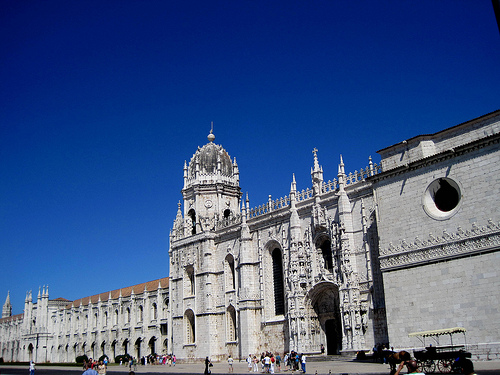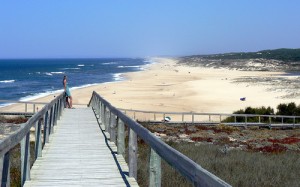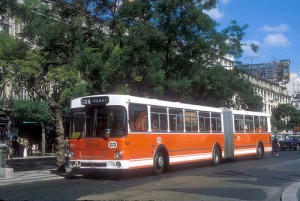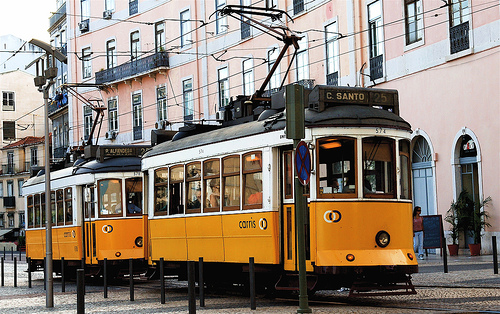 While most people think of Porto (or Oporto) as straddling the Douro river, that’s actually incorrect. Porto is located on the north side of the Douro while the south side, where the port houses are located, is actually called Vila Nova de Gaia. The two cities are connected by a bridge which carries cars, a tram and pedestrians over the river.
While most people think of Porto (or Oporto) as straddling the Douro river, that’s actually incorrect. Porto is located on the north side of the Douro while the south side, where the port houses are located, is actually called Vila Nova de Gaia. The two cities are connected by a bridge which carries cars, a tram and pedestrians over the river.
Visitors to Porto are generally better off without a car; the streets can be confusing (and some require special permits to drive on), parking is hard to come by, and public transport is cheap and easy to use. Here’s what you need to know about getting around in Porto.
From the airport or train station
Porto Airport has a station on the Metro do Porto light-rail/tram system. Depending on where in Porto or Gaia you are staying, it will take about 20-30 minutes to arrive and you may need to change train lines or take a cab from the city center (especially if you are staying on the Gaia side) once you arrive. The tram from the airports costs just a few euros (the price will vary depending on your destination) and there are attendants at the airport to help you plan your route and use the automated machines. Be aware that the machines only take change, no bills.
The main train station – Porto Campanhã – is on the east side of the city, about 2 kilometers from the center. Upon arrival, you can take a local Urbanos train 5 minutes to the city center station of São Bento or take a cab to your final destination.
Trams/light rail and bus
The public transportation system in Porto is excellent and made up on trams, buses and the Metro do Porto , a network of six tram or light-rail lines that run every 10 – 20 minutes from 6am until after midnight. Ticketing on most buses, trams and rail is integrated under the ANDANTE system using zones to set the fares. The trams – four-wheeled wooden trams from the 1920’s – run about every 30 minutes on three different lines. Line 1 is the most popular with tourists, taking them from Porto to the leafy and upscale suburb of Foz. There’s also a funicular that runs from the Ribeira (riverfront) up the hill towards the city center.
Cabs
Cabs are plentiful and cheap (compared to other European countries) in Porto. It’s safe to hail one on the street, just make sure the meter is on or that you negotiate a fare beforehand. Most taxi drives speak enough English to take direction, but if you are headed to a less touristy destination, it’s wise to have the address written out for the driver. It’s common to tip a taxi driver 10% of the fare.
Walking
Most of Porto is easily accessed on foot as many of the main attractions are located in a small area. However, Porto is quite hilly and walking up from the riverfront (on either side) can be tiring. Especially if you are headed from the riverfront to the city center of Porto, consider taking a cab or riding the Funicular to save your legs.
Photo by b00nj
 Belém, a parish of Lisbon, sits at the mouth of the Tagus River, six kilometers west of the city center. It’s home to a number of museums and monuments, including the
Belém, a parish of Lisbon, sits at the mouth of the Tagus River, six kilometers west of the city center. It’s home to a number of museums and monuments, including the  While in Belém, don’t miss a stop at the Pastéis de Belém shop just up the street from the Monastery. A pastéis de Belém (or pastéis de nata) is perhaps Portugal’s most famous export. This creamy custard tart can be found all over the country, but many say the best one can still be found at the original shop in Belém. The story goes that the pastéis de natas was created before the 18th century by Catholic nuns at the Jerónimos Monastery. In 1837 the
While in Belém, don’t miss a stop at the Pastéis de Belém shop just up the street from the Monastery. A pastéis de Belém (or pastéis de nata) is perhaps Portugal’s most famous export. This creamy custard tart can be found all over the country, but many say the best one can still be found at the original shop in Belém. The story goes that the pastéis de natas was created before the 18th century by Catholic nuns at the Jerónimos Monastery. In 1837 the 
 Just like
Just like  Portugal is very well served by low-cost carriers but when it comes to traveling within the country, unless you want to go to the islands, you are better off using the land transportation: train and bus.
Portugal is very well served by low-cost carriers but when it comes to traveling within the country, unless you want to go to the islands, you are better off using the land transportation: train and bus.  Central Lisbon is relatively compact and easy to navigate. Set on seven hills, the city streets are a mix of wide open lanes and narrower, steep cobblestone streets. With old tram cars rattling past modern buses, the transportation options are equally diverse. Here’s what you need to know about getting around in Lisbon.
Central Lisbon is relatively compact and easy to navigate. Set on seven hills, the city streets are a mix of wide open lanes and narrower, steep cobblestone streets. With old tram cars rattling past modern buses, the transportation options are equally diverse. Here’s what you need to know about getting around in Lisbon. Portugal doesn’t get nearly the recognition it deserves as a culinary and wine destination. In Western Europe, it’s often overlooked for Spain, Italy, and France. But what many people don’t realize is that wine-lovers – especially those on a smaller budget – should be flocking here in droves. Portugal is one of the
Portugal doesn’t get nearly the recognition it deserves as a culinary and wine destination. In Western Europe, it’s often overlooked for Spain, Italy, and France. But what many people don’t realize is that wine-lovers – especially those on a smaller budget – should be flocking here in droves. Portugal is one of the  The Algarve is the name given to Portugal’s stunningly scenic south coast. It is a place of world class beaches, impeccable golf courses and quaint hillside villages, and with the heavenly year-round temperatures this destination has firmly established itself as one of the best getaways on the planet. There are numerous areas to stay – some quiet and peaceful; others loud and boozy – and Algarve accommodation ranges from gleaming five star hotels to basic beachside campsites.
The Algarve is the name given to Portugal’s stunningly scenic south coast. It is a place of world class beaches, impeccable golf courses and quaint hillside villages, and with the heavenly year-round temperatures this destination has firmly established itself as one of the best getaways on the planet. There are numerous areas to stay – some quiet and peaceful; others loud and boozy – and Algarve accommodation ranges from gleaming five star hotels to basic beachside campsites. Slide and Splash, located 25 minutes outside the town of Lagos (which sits on the western fringes of the Algarve) is by far the best waterpark in the whole region. It boasts an Olympic sized swimming pool, every type of slide you can think of and 25,000 square metres of grassy areas. You can chill out with a cocktail and a burger under a shady palm tree or take the plunge down the Kamikaze – an enormous slide that sees you reach tremendous speeds before being spat out into a large pool. There are plenty of kiosks selling ice creams and drinks and also a stylish self-service restaurant for those who are feeling extra peckish. The lifeguards manning each ride and the general safety of the place makes this an ideal day out for families with young children.
Slide and Splash, located 25 minutes outside the town of Lagos (which sits on the western fringes of the Algarve) is by far the best waterpark in the whole region. It boasts an Olympic sized swimming pool, every type of slide you can think of and 25,000 square metres of grassy areas. You can chill out with a cocktail and a burger under a shady palm tree or take the plunge down the Kamikaze – an enormous slide that sees you reach tremendous speeds before being spat out into a large pool. There are plenty of kiosks selling ice creams and drinks and also a stylish self-service restaurant for those who are feeling extra peckish. The lifeguards manning each ride and the general safety of the place makes this an ideal day out for families with young children. Aquashow, situated just outside the town of Quarteira, had to be included in this rundown simply for the Water Roller Coaster, which holds the coveted title of being the biggest in Europe. The kilometre-long ride will see you go in and out of the water, fly round sharp corners and reach speeds of 70 kilometres per hour – all in your trunks and bikinis. Other attractions here include the White Fall (an exhilarating donut ride), the Wild Snake (a fantastic waterslide) and an enormous wave pool.
Aquashow, situated just outside the town of Quarteira, had to be included in this rundown simply for the Water Roller Coaster, which holds the coveted title of being the biggest in Europe. The kilometre-long ride will see you go in and out of the water, fly round sharp corners and reach speeds of 70 kilometres per hour – all in your trunks and bikinis. Other attractions here include the White Fall (an exhilarating donut ride), the Wild Snake (a fantastic waterslide) and an enormous wave pool. The Azores are among the most undisturbed and isolated islands in Europe. Located nearly 1000 miles from the mainland of Portugal the islands are serviced with regular
The Azores are among the most undisturbed and isolated islands in Europe. Located nearly 1000 miles from the mainland of Portugal the islands are serviced with regular